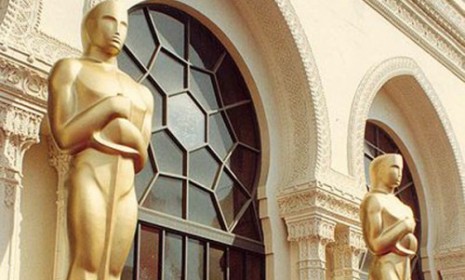6 ugliest Oscar smear campaigns
As "The Hurt Locker" producers know, publicity can cut two ways. Here, media takedowns that ruined the Oscar prospects for other famous films

One of the tensest Oscar campaign seasons ends today at 5 p.m. (the deadline to submit ballots), with indie frontrunner, "The Hurt Locker," embroiled in two scandals. The first erupted when one of its producers allegedly played dirty with an "illegal" email campaign; the second exploded after The Los Angeles Times challenged the war film's accuracy. Some allege that the Times's piece, in which soldiers dismiss 'The Hurt Locker' as laughable and "disrespectful," may have been instigated by rival producers. The "additional reporting by ["Inglourious Basterds" executive producer] Harvey Weinstein" credit appears to have been left off the story, says S.T. Vanairsdale at Movieline.com. If so, it wouldn't be the first time desperate movie makers have tried to use the press to sway Academy voters. Here's a brief history of notorious Oscar smear tactics:
1. EXECUTE A PRESS FREEZE-OUT
The movie: "Citizen Kane," nominated for nine Academy Awards, including Best Picture, in 1942, and now revered as one of the best American films ever made.
The Week
Escape your echo chamber. Get the facts behind the news, plus analysis from multiple perspectives.

Sign up for The Week's Free Newsletters
From our morning news briefing to a weekly Good News Newsletter, get the best of The Week delivered directly to your inbox.
From our morning news briefing to a weekly Good News Newsletter, get the best of The Week delivered directly to your inbox.
The smear: Newspaper magnate William Randolph Hearst, on whom the film's main character was closely based, banned any mention of the film in his papers, used his influence to limit its theatrical run, and publicly slandered director Orson Welles.
Did it work? Yes. "Citizen Kane" only took home one Oscar for Best Screenplay, losing Best Picture to the relatively obscure "How Green Was My Valley." The audience reportedly booed when Welles' name was mentioned.
2. PAINT THE FILM AS PINKO
The movie: "High Noon," nominated for seven Academy Awards, including Best Picture, in 1953.
A free daily email with the biggest news stories of the day – and the best features from TheWeek.com
The smear: Exploiting McCarthy-era fears, rival studios spread rumors that the acclaimed Western was pushing a liberal and making "un-American" statements about Hollywood's anti-communist blacklist and U.S. foreign policy regarding the Korean War.
Did it work? Yes. Despite critical praise and the allures of Grace Kelly, Oscar voters were too intimidated to support "High Noon." It lost the top award to Cecil B. De Mille's overblown circus spectacle, "The Greatest Show on Earth."
3. EXPOSE HISTORICAL INACCURACIES
The movie: Director Steven Spielberg's "Saving Private Ryan," nominated for 11 Academy Awards, including Best Picture, in 1998.
The smear: After reports questioned the film's research, entertainment journalists admitted that publicists at Miramax (which was pushing "Ryan"'s top rival, "Shakespeare in Love") had asked them to criticize the film.
Did it work? For the most part, yes. While "Shakespeare in Love" took home six Oscars, including Best Picture and Best Actress (Gwyneth Paltrow), the Academy gave the Best Director award to Spielberg, a rare split of the Best Director and Best Picture awards.
4. PLAY THE ANTI-SEMITISM CARD
The movie: "A Beautiful Mind," nominated for eight Academy Awards, including Best Picture, in 2002.
The smear: Two weeks before voting closed, the Drudge Report claimed the biopic's makers had conveniently concealed that their subject, John Nash, was anti-Semitic and said some Academy member were questioning why they would vote for a "Jew hater." Reportedly, a rival film's Oscar "strategist" even called the LA Times to make sure its reporters saw the Drudge post.
Did it work? No. The otherwise heartwarming film prevailed, snagging four statuettes, including those for Best Picture and Best Director.
5. COUNTERSPIN
The movie: Director Roman Polanski's "The Pianist," nominated for seven Academy Awards, including Best Picture and Best Director, in 2003.
The smear: After Samantha Geimer, the erstwhile minor with whom Polanski had "unlawful sex" in 1977, publically forgave him and wrote an LA Times editorial calling on Oscar voters to "judge the movie, not the man." Rival studios allegedly tried to halt the pro-Polanski momentum — leaking old court transcripts that graphically detailed Polanski's assault on Geimer.
Did it work? Not entirely. Though "Chicago" was named Best Picture, Polanski won for Best Director, and "The Pianist" nabbed statuettes for Best Adapted Screenplay and Best Actor (Adrien Brody).
6. LEVEL CHARGES OF CHILD EXPLOITATION
The movie: "Slumdog Millionaire," nominated for ten Academy Awards, including Best Picture and Best Director, in 2009.
The smear: The media criticized director Danny Boyle for underpaying the film's impoverished child stars, raising suspicions that rival studio publicists had found a powerful angle to take down the film; "Slumdog" studio Fox Searchlight quickly issued press releases pushing the fact that Boyle had set-up trustfunds for the kids.
Did it work? No. The film swept the Oscars — winning eight Oscars including Best Picture.
.........................................
SEE MORE OF THE WEEK'S RECENT COVERAGE OF THE OSCARS:
• Oscar uproar: "The Hurt Locker" mess-up
• 10 reasons why 10 "Best Picture" nominations is a bad idea
-
 Political cartoons for December 21
Political cartoons for December 21Cartoons Sunday’s political cartoons include Christmas movies, AI sermons, and more
-
 A luxury walking tour in Western Australia
A luxury walking tour in Western AustraliaThe Week Recommends Walk through an ‘ancient forest’ and listen to the ‘gentle hushing’ of the upper canopy
-
 What Nick Fuentes and the Groypers want
What Nick Fuentes and the Groypers wantThe Explainer White supremacism has a new face in the US: a clean-cut 27-year-old with a vast social media following